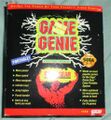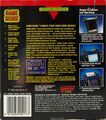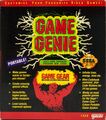Difference between revisions of "Game Genie (Mega Drive)"
From Sega Retro
| Line 46: | Line 46: | ||
A scrapped [[Sega Mega-CD]] version of the Game Genie was also in the works and was designed to fit in between the Mega CD and Mega Drive and would intercept code as it passed in between the two. It was only known to work with the Mega Drive 2 and the Sega Mega-CD 2.[[:File:Egm Issue052 November 1993 Page064.jpg|[1]]] | A scrapped [[Sega Mega-CD]] version of the Game Genie was also in the works and was designed to fit in between the Mega CD and Mega Drive and would intercept code as it passed in between the two. It was only known to work with the Mega Drive 2 and the Sega Mega-CD 2.[[:File:Egm Issue052 November 1993 Page064.jpg|[1]]] | ||
| + | ==Promotional Material== | ||
| + | <gallery> | ||
| + | File:GameGenie MD Flyer.jpg|Mega Drive US print advert | ||
| + | File:GameGenie GG Flyer.jpg|Game Gear US print advert | ||
| + | </gallery> | ||
==Physical Scans== | ==Physical Scans== | ||
===Mega Drive Version=== | ===Mega Drive Version=== | ||
| Line 76: | Line 81: | ||
| back= | | back= | ||
| cart=GameGenie MD UK Cart.jpg | | cart=GameGenie MD UK Cart.jpg | ||
| + | }}{{Scanbox | ||
| + | | console=Mega Drive | ||
| + | | region=UK (Extra Power) | ||
| + | | front=GameGenieExtraPower MD EU Box Front.jpg | ||
| + | | back= | ||
| + | | cart=GameGenieExtraPower MD EU Cart.jpg | ||
}}{{Scanbox | }}{{Scanbox | ||
| console=Mega Drive | | console=Mega Drive | ||
| Line 90: | Line 101: | ||
}} | }} | ||
| − | |||
| − | |||
| − | |||
| − | |||
| − | |||
===Game Gear Version=== | ===Game Gear Version=== | ||
| Line 110: | Line 116: | ||
| spinemissing=yes | | spinemissing=yes | ||
| cart= | | cart= | ||
| − | |||
| − | |||
| − | |||
| − | |||
| − | |||
| − | |||
}} | }} | ||
Revision as of 13:49, 16 September 2014
| Game Genie (Mega Drive) | |||||
|---|---|---|---|---|---|
| Made for: Sega Mega Drive, Sega Game Gear | |||||
| Manufacturer: Galoob | |||||
|
The Game Genie is a series of specialised "cheat cartridges" (or "video game enhancers") developed by Codemasters which allows the user to manipulate video games. Multiple Game Genies were created during the late 1980s and early 1990s, including cartridges for the Sega Mega Drive and Sega Game Gear.
Though developed by Codemasters, distribution was handled by Camerica in Canada and Galoob in the United States (and Europe, with the help of third-party distributors). Following the controversy of a Nintendo Entertainment System version of the device - of which Nintendo unsuccessfully tried to block, the Mega Drive and Game Gear enhancers were adopted by Sega as officially licensed products. The Game Genie brand has since been discontinued, however the idea lived on through Action Replay and GameShark hacking devices on newer consoles in the years which followed. Game Genie codes have since become a supported feature in most emulators.
Contents
Operation
The Game Genie attaches to the end of a cartridge and is then inserted into the cartridge port of the console for which it was designed.
Upon starting the console, the player may enter a series of characters referred to as a "code" or several such series that reference addresses in the ROM of the cartridge. Each code contains an integer value that is read by the system in place of the data actually present on the cartridge. The Game Genie cannot manipulate RAM, though it can make the console read different values from SRAM.
Because they patch the program code of a game, Game Genie codes are sometimes referred to as patch codes. These codes can have a variety of effects. The most popular codes give the player some form of invulnerability, infinite ammunition, level skipping, or other modifications that allow the player to be more powerful than intended by the developers. In rare cases, codes even unlock hidden game features that developers had scrapped and rendered unreachable in normal play (an example of this is the final Hidden Palace Zone in Sonic 2).
The Game Genie was usually sold with a small booklet of discovered codes for use with the system. However, these booklets would eventually become inadequate as new codes were discovered and new games were released that were not covered. To address this, an update system was implemented, where subscribers would receive quarterly booklet updates for a fee. In addition Galoob also ran ads in certain gaming publications (such as GamePro) that featured codes for newer games. Today, these codes and many others discovered by players can be found for free online.
Mega Drive
On the Sega Mega Drive, the Game Genie can function as a country converter and bypass the TMSS (TradeMark Security System) since most of these games are only "locked" to their respective regions by the shape of the cartridges and a set of a few bytes in the header of the ROM. In other cases Game Genie codes can be entered to allow a game to be played on any region console.
Game Gear
The Sega Game Gear's Game Genie has a more complicated design than those for other systems. When inserted into the cartridge slot, another slot will pop-up to insert the Game Gear cartridge. It also has a compartment which contained a book of codes.
The codes were printed on sticky labels to put on the back of the Game Gear cartridge. When entering codes, the player could easily see what to type in rather than looking through the book. Many of these codes can now be found online as well.
On the screen in which a code is entered for the Game Gear Game Genie, a player typing the word "DEAD" will cause the screen to move up and down, possibly as an Easter egg.
Scrapped Game Genies
New Game Genies called "Game Genie 2" were in the works in 1993 which would store codes and not require codes to be entered each time booting up the system. It was also going to have code searching features similar to the Pro Action Replay. This means it could probably alter RAM as searching for codes that affect ROM would have been more difficult. Due to some Game Genies recently being released it was decided to hold off the release of the new version till at least the following year but wound up being scrapped instead.
A scrapped Sega Mega-CD version of the Game Genie was also in the works and was designed to fit in between the Mega CD and Mega Drive and would intercept code as it passed in between the two. It was only known to work with the Mega Drive 2 and the Sega Mega-CD 2.[1]
Promotional Material
- GameGenie MD Flyer.jpg
Mega Drive US print advert
- GameGenie GG Flyer.jpg
Game Gear US print advert
Physical Scans
Mega Drive Version
Game Gear Version
External Links
- Gamegenie.com - An unofficial codes site which uses the Game Genie name
- GSHI - Complete collection of Official Game Genie codes
| Sega Game Gear | |
| Topics | Sega Game Gear | History | Magazine articles | Promotional material | Merchandise |
|---|---|
| Hardware | Japan | North America | Western Europe | Eastern Europe | Asia | South America | Australasia | Africa Wide Gear | Fun Play 20-in-1 |
| Add-ons | Pro Action Replay | Game Genie | X-Terminator | Master Gear Converter (Gear Master | Nuby Converter) | Stereo FM Tuner | TV Tuner |
| Cases | Carry-All | Deluxe Carry-All Case | Gear Bag | Holster Case | Standard Carrying Case | Soft Case | Third Party (Play & Carry Case) |
| Accessories | A/V Cable | Battery Pack | Car Adaptor | Car Antenna | Cleaning Gear | Gear-to-Gear Cable | PowerBack (Third Party) | Screen Magnifier (Wide Gear | Super Wide Gear | Third-Party) |
| Development Tools | Sega Game Gear Development Board |
| Sega Mega-CD | |
|---|---|
| Topics | Technical specifications | History | Magazine articles | Promotional material |
| Hardware | Mega CD (Asia | North America | Western Europe | Eastern Europe | South America | Australasia | Africa) Sega Multi-Mega (Asia | North America | Europe | South America | Australasia) Wondermega | LaserActive | CSD-G1M |
| Misc. hardware | CD BackUp RAM Cart | Mega-CD Karaoke | Pro CDX |
| Development tools | SNASM Mega-CD | PsyQ Mega-CD SDK | PSY-Q CD Emulation System (Mega-CD) |
| Unreleased hardware | Game Genie |









